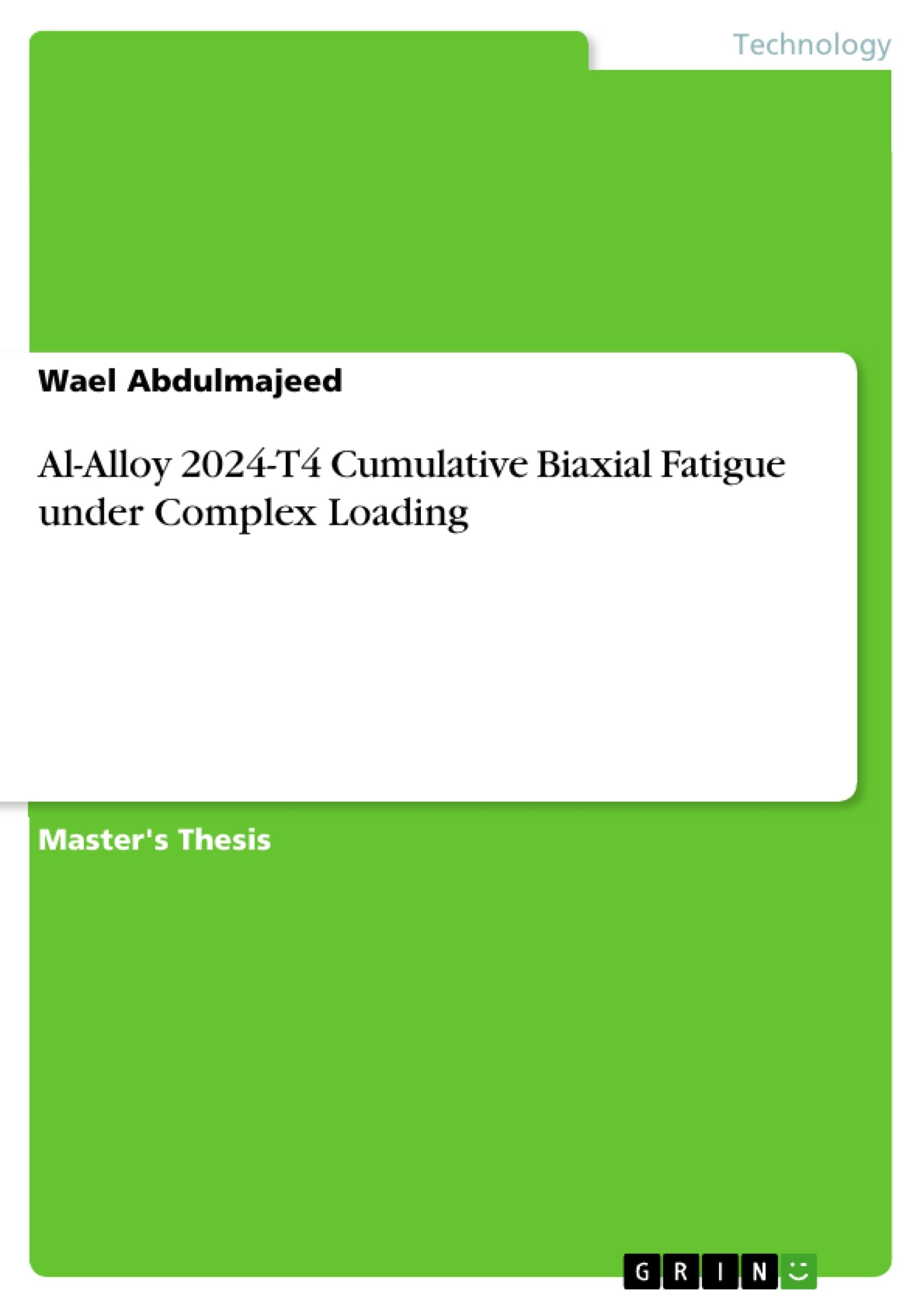A study of metal cumulative fatigue damage at multilevel stress programs using 2024- T 4 AI -Alloy is carried out in this investigation. Specimens are designed and fabricated. The tests are performed under multiaxial fatigue in phase combined loading bending and torsion, with zero mean stress (R=-l) at room temperature.
Five groups of multiaxial fatigue experiments are performed, constant amplitude, linear increasing and decreasing, Low-High loading sequence, High-Low loading sequence and equivalent flight loading fatigue.
Prediction of life specimens are studied at three methods:
Palmgren-Miner, Corten - Dolan, and Marsh. The methods are conservative to some specimens and non-conservative to another. The effects of stage life (ns) have been examined and fatigue life of specimens are decreased when the stage life is decreased.
Comparisons between High-Low & Low-High loading sequences in fatigue life (multi stress level) have been investigated. The Low-High loading sequence is less dangerous than High-Low loading sequence at the same stress range (equal loading stages).
Studies the effect of stress range fatigue life have been investigated and the fatigue life is decreased with increasing the stress range fatigue (having the same lowest stress).
For the fatigue of equivalent flight loading, the life is depend basically on stress range and the cruising interval this two parameters have been studied.
Inhaltsverzeichnis (Table of Contents)
- CHAPTER ONE AIRCRAFT FATIGUE
- (1.1) Introduction
- (1.2) Literature Survey
- (1.3) Objectives
- CHAPTER TWO MULTIAXIAL FATIGUE
- (2.1) Introduction
- (2.2) Parameters Affecting Biaxial Fatigue
- (2.2.A) Isotropy In Biaxial Fatigue
- (2.2.B) Mean Stress Effect
- (2.2.C) Phase Effect
- (2.2.D) Effect Of Notches
- (2.3) MULTIAXIAL FATIGUE FAILURE THEORIES
- (2.3.1) Gough's Theory
- (2.3.2) Maximum Shear Stress Theory
- (2.3.3) Octahedral Shear Stress Theory
- (2.3.4) Equivalent Stress Theories
- (2.4) Cumulative fatigue Damage Theories
- (2.4.1) Introduction
- (2.4.2) The Linear Damage Theory
- (2.4.3) Cotten-Dolan Cumulative Damage Theory
- (2.4.4) Marsh Cumulative Damage Theory
- CHAPTER THREE EXPERIMENTAL WORK
- (3.1) Introduction
- (3.2) Material
- (3.2.1) Chemical Composition
- (3.2.2) Mechanical Properties
- (3.2.3) Tensile Test
- (3.2.4) Grain Size Measurement
- (3.3) Specimens Preparation
- (3.4) Test Rig
- (3.5) Applied Combined Loading
- (3.6) Test Series
- CHAPTER FOUR EXPERIMENTAL RESULTS
- (4.1) Introduction
- (4.2) Group (1) Results
- (4.3) Group (2) Results
- (4.4) Group (3) Results
- (4.5) Group (4) Results
- (4.6) Group (5) Results
- CHAPTER FIVE DISCUSSION
- (5.1) S-N Curve
- (5.2) Fatigue Limit
- (5.3) Cumulative Fatigue Damage Theories
- (5.3.1) Introduction
- (5.3.2) Palmgren-Miner Method Application
- (5.3.3) Corten-Dolan Method
- (5.3.4) Marsh Prediction Method
- (5.4) Stage Life Effect On Fatigue Life
- (5.5) Loading Sequence Effect
- (5.6) Comparison Between Specimens Having Same Stress Difference (τH - τL) With Different Stress Level
- (5.7) Special Programs Represent Flight Loading
Zielsetzung und Themenschwerpunkte (Objectives and Key Themes)
The primary goal of this investigation is to comprehensively examine the cumulative fatigue damage of aluminum alloy 2024-T4 under various multilevel stress programs. This research focuses on understanding the impact of stage life, loading sequences, and different life prediction methods on the fatigue behavior of the material.
- Cumulative fatigue damage under multilevel stress programs
- Effect of stage life (ns) on fatigue life
- Influence of loading sequences (High-Low & Low-High) on fatigue properties
- Evaluation of fatigue life prediction methods (Palmgren-Miner, Corten-Dolan, and Marsh)
- Fatigue behavior under loading programs simulating aircraft flight conditions
Zusammenfassung der Kapitel (Chapter Summaries)
Chapter One provides an introduction to the subject of aircraft fatigue, highlighting its historical significance and the challenges faced by aircraft designers in mitigating fatigue-related issues. The chapter reviews relevant literature and outlines the objectives of the current investigation.
Chapter Two delves into the complexities of multiaxial fatigue, exploring key parameters that influence fatigue behavior, including isotropy, mean stress, phase effects, and the influence of notches. The chapter also presents various theories used to predict fatigue failure under combined stress conditions, focusing on the linear damage theory, Corten-Dolan theory, and Marsh theory.
Chapter Three outlines the experimental methodology employed in the investigation. This chapter describes the material used, including its chemical composition and mechanical properties, as well as the preparation of specimens and the testing equipment. The chapter concludes with a detailed explanation of the various test series conducted.
Chapter Four presents the experimental results obtained from the different test series, detailing the loading programs, shear stress amplitudes, and the number of cycles to fracture for each specimen. The chapter organizes the results based on the five groups of tests performed.
Schlüsselwörter (Keywords)
This research focuses on the cumulative fatigue damage of 2024-T4 aluminum alloy under multiaxial loading. The key concepts include multilevel stress programs, stage life, loading sequences, life prediction methods (Palmgren-Miner, Corten-Dolan, and Marsh), and flight loading simulations. The investigation analyzes the effect of these factors on the fatigue behavior of the material, providing insights into the complexities of fatigue failure in structural components.
- Citation du texte
- Ph.D Mech. Eng. Wael Abdulmajeed (Auteur), 1997, Al-Alloy 2024-T4 Cumulative Biaxial Fatigue under Complex Loading, Munich, GRIN Verlag, https://www.grin.com/document/213420



